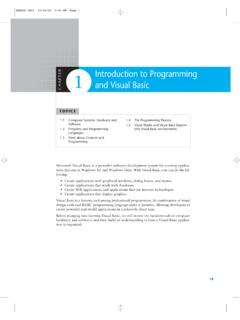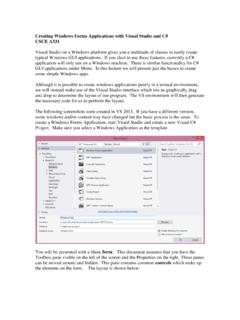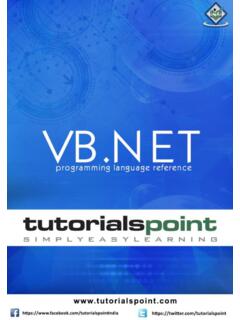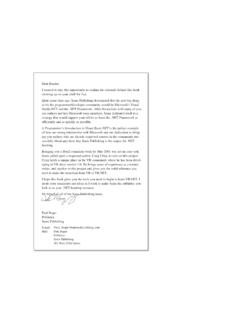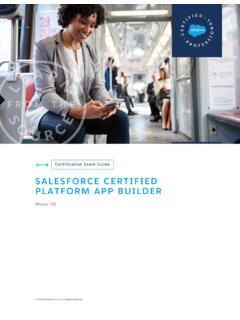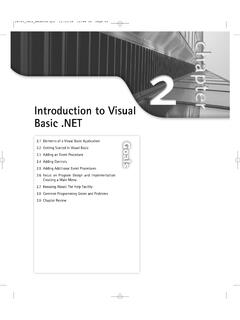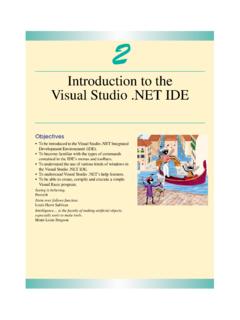Transcription of Programming Visual Basic.NET
1 Programming Visual Basic .NET Dave Grundgeiger Publisher: O'Reilly First Edition January 2002 ISBN: 0-596-00093-6, 464 pages Published just in time for the first release of Visual Basic Studio .NET, Programming Visual Basic .NET is a programmer's complete guide to Visual Basic .NET. Starting with a sample application and a high-level map, the book jumps right into showing how the parts of .NET fit with Visual Basic .NET. Topics include the common language runtime Windows Forms, , Web Forms, Web Services, and 2 Organization of This Conventions Used in This How to Contact Chapter 1. What Is the Microsoft .NET Framework?..13 What Is Visual Basic .NET?..14 An Example Visual Basic .NET Chapter 2. The Visual Basic .NET Source Symbolic Access Operators and Standard Conditional Chapter 3.
2 The .NET Common Language Infrastructure (CLI) and Common Language Runtime (CLR)..111 Common Type System (CTS)..111 Portions of the Modules and Application Common Language Specification (CLS)..116 Intermediate Language (IL) and Just-In-Time (JIT) Compilation117 Memory Management and Garbage A Brief Tour of the .NET Framework Programming Visual Basic .NET 3 Chapter 4. Windows Forms I: Developing Desktop Creating a Handling Form Relationships Between MDI Component 2-D Graphics Programming with GDI+..160 Chapter 5. Windows Forms II: Controls, Common Dialog Boxes, and Common Controls and Control Form and Control Common Dialog Creating a Chapter 6. and Web Forms: Developing Browser-Based Applications237 Creating a Web Handling Page More About Server Adding Using Directives to Modify Web Page Objects: Interacting with the Discovering Browser Maintaining Application-Level Code and Web-Application Designing Custom Chapter 7.
3 Web Creating a Web Testing a Web Service with a Web-Service Consuming a Web Web-Service Limitations of Web Chapter 8. : Developing Database A Brief History of Universal Data Managed Connecting to a SQL Server SQL Server Connecting to an OLE DB Data Reading Data into a 4 Relations Between DataTables in a The DataSet's XML Binding a DataSet to a Windows Forms Binding a DataSet to a Web Forms Typed Reading Data Using a Executing Stored ProceduresThrough a SqlCommand Appendix A. Custom Attributes Defined in the System Appendix B. Exceptions Defined in the System Appendix D. Resources for .NET Discussion Appendix E. Math Programming Visual Basic .NET 5 Programming Visual Basic .NET Preface Organization of This Book Conventions Used in This Book How to Contact Us Acknowledgments 1.
4 Introduction What Is the Microsoft .NET Framework? What Is Visual Basic .NET? An Example Visual Basic .NET Program 2. The Visual Basic .NET Language Source Files Identifiers Keywords Literals Types Namespaces Symbolic Constants Variables Scope Access Modifiers Assignment Operators and Expressions Statements Classes Interfaces Structures Enumerations Exceptions Delegates Events Standard Modules Attributes Conditional Compilation Summary 3. The .NET Framework Common Language Infrastructure (CLI) and Common Language Runtime (CLR) Common Type System (CTS) Portions of the CLI Modules and Assemblies Application Domains Common Language Specification (CLS) Intermediate Language (IL) and Just-In-Time (JIT) Compilation Metadata Memory Management and Garbage Collection A Brief Tour of the.
5 NET Framework Namespaces Configuration Summary 4. Windows Forms I: Developing Desktop Applications Creating a Form Handling Form Events Relationships Between Forms 6 MDI Applications Component Attributes 2-D Graphics Programming with GDI+ Printing Summary 5. Windows Forms II: Controls, Common Dialog Boxes, and Menus Common Controls and Components Control Events Form and Control Layout Common Dialog Boxes Menus Creating a Control Summary 6. and Web Forms: Developing Browser-Based Applications Creating a Web Form Handling Page Events More About Server Controls Adding Validation Using Directives to Modify Web Page Compilation Objects: Interacting with the Framework Discovering Browser Capabilities Maintaining State Application-Level Code and Web-Application Security Designing Custom Controls Summary 7.
6 Web Services Creating a Web Service Testing a Web Service with a Browser Web-Service Descriptions Consuming a Web Service Web-Service Discovery Limitations of Web Services Summary 8. : Developing Database Applications A Brief History of Universal Data Access Managed Providers Connecting to a SQL Server Database Connecting to an OLE DB Data Source Reading Data into a DataSet Relations Between DataTables in a DataSet The DataSet's XML Capabilities Binding a DataSet to a Windows Forms DataGrid Binding a DataSet to a Web Forms DataGrid Typed DataSets Reading Data Using a DataReader Executing Stored ProceduresThrough a SqlCommand Object Summary A. Custom Attributes Defined in the System Namespace AttributeUsage CLSC ompliant ContextStatic Programming Visual Basic.
7 NET 7 Flags LoaderOptimization MTAT hread NonSerialized Obsolete ParamArray Serializable STAT hread ThreadStatic B. Exceptions Defined in the System Namespace C. Cultures D. Resources for Developers .NET Information Discussion Lists E. Math Functions Colophon 8 Programming Visual Basic .NET 9 Preface The purpose of this book is to provide experienced software developers with the means to quickly become productive in Microsoft's Visual Basic .NET development environment. The only assumption I make about you as a programmer is that you're comfortable with the concepts and processes of software development. This book will not teach you how to program. However, if you're currently a working Visual Basic, C++, or Java developer, this book will help you transfer your existing skills to this new environment. Organization of This Book This book contains eight chapters and four appendixes.
8 Chapter 1 starts out with three short hello, world examples that show how to enter and compile a console app, a GUI app, and a browser app. This gives the reader immediate gratification. The chapter also provides an overview of the .NET Framework and Visual Basic .NET. Chapter 2 examines the syntax and use of the Visual Basic .NET language. This will not teach someone how to program, but it will teach a programmer how to program in Visual Basic .NET. Chapter 3 explains the various components of the .NET Framework and explains why the .NET Framework is a Good Thing. Chapter 4 explains how to use the Windows Forms class library for building GUI applications. Chapter 5 picks up where Chapter 4 left off by discussing individual controls, showing how to use the common dialog boxes available in the .NET Framework, and examining menu creation and use. Chapter 6 explains how to use the Web Forms class library for building browser-based applications.
9 Chapter 7 talks about building components that provide services over the Internet and how to consume those services. Chapter 8 explains the distributed, stateless, disconnected data model encapsulated by Appendix A provides a list of the types known as attributes. The concept of attributes is discussed in Chapter 2. Appendix B provides a list of system-generated exceptions. The concept of exceptions is discussed in Chapter 2. Appendix C provides a list of culture names and IDs for globalization. Appendix D provides a list of online resources where developers can get help and further information on Visual Basic .NET. Appendix E lists the standard math functions that are available to the Visual Basic .NET programmer via the .NET Framework's Math class. Conventions Used in This Book Throughout this book, we've used the following typographic conventions: 10 Constant width Constant width in body text indicates a language construct, such as the name of a stored procedure, a SQL statement, a Visual Basic.
10 NET statement, an enumeration, an intrinsic or user-defined constant, a structure ( , a user-defined type), or an expression (like dblElapTime = Timer - dblStartTime). Code fragments and code examples appear exclusively in constant-width text. In syntax statements and prototypes, text set in constant width indicates such language elements as the function or procedure name and any invariable elements required by the syntax. Constant width italic Constant width italic in body text indicates parameter names. In syntax statements or prototypes, constant width italic indicates replaceable parameters. In addition, constant width italic is used in body text to denote variables. Italic Italicized words in the text indicate intrinsic or user-defined function and procedure names. Many system elements, such as paths and filenames, are also italicized. URLs and email addresses are italicized.
